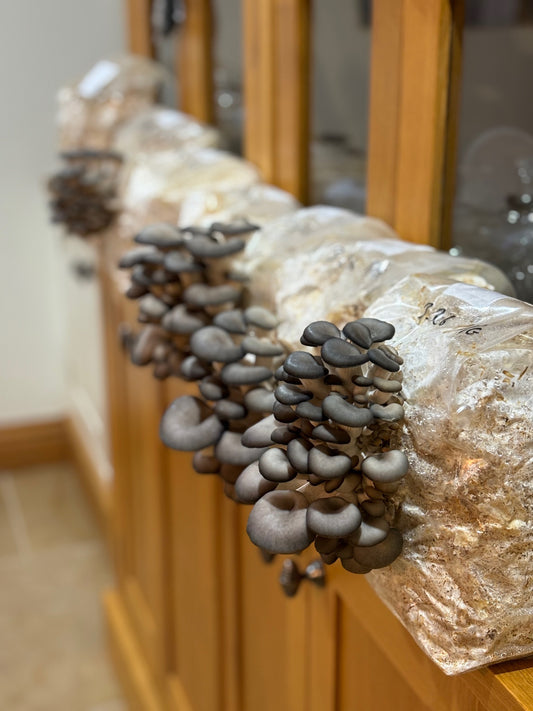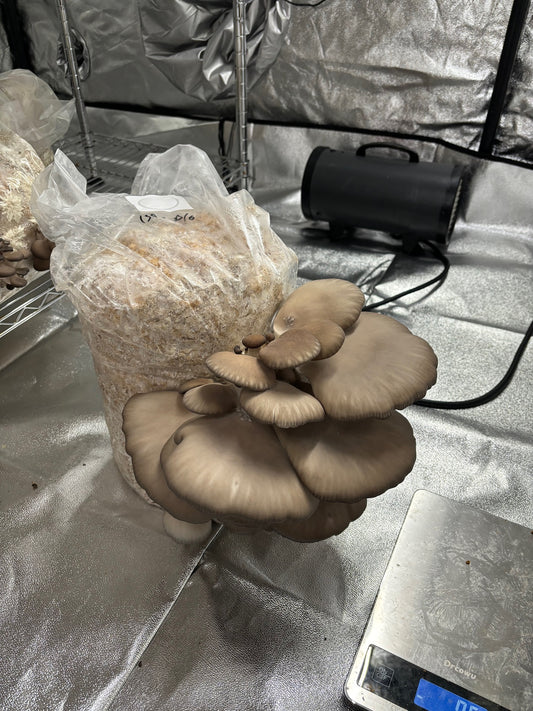There are too many intriguing facts about fungi to list in one space, but the following have been handpicked as five of our favourites. They genuinely were the starting point that inspired us to learn more about mushroom farming, and have ultimately led us to create the business we've become very proud of.
We hope you enjoy them as much as we did.
They were called prototaxites. Standing up to 26 feet tall, and spanning a metre wide, these massive structures grew across the entire surface of our Earth. Scientists have discovered prototaxite fossils dating back 400 million years.
It is speculated that prototaxites gradually became extinct once small insects appeared on the scene, and realised the feasting potential of an organism that had little ability to defend itself. In short - they ate them all!
This allowed for plants and trees to take over, leading to the green and blue planet we know and love.

2. The 'Stoned Ape' theory
Magic mushrooms in particular have played a huge part in the development of our communication skills, memory recall and all sorts of human creativity - or so the theory runs. This idea has most recently been credited to myconaut Terrence McKenna, although it has definitely been in existence among scientific thought for a while.
Psilocybin - the hallucinogenic compound found in magic mushrooms - had always had powerful effects on the human brain. It activates our serotonin receptors and fosters stronger neural pathway connections. Magic mushrooms grow easily, quickly and widespread. Our ancestors on the African savanna would have eaten them as part of their regular diet.
It’s entirely possible that our language development, ability to use tools and evolutionary neural plasticity are the results of these magical little fruiting bodies. A pretty wild claim, and not always recognised as a legitimate hypothesis, but an interesting one nonetheless.

3. The Wood Wide Web
Picture a vast forest of trees, stood two or three metres apart. They appear to be independent, modestly occupying their assigned spot in the ground. Under ground, though, a vast subterranean network exists within the soil. It’s made up of tree roots and fungi mycelium - and it links each individual tree together to create the Wood Wide Web.
Known as a mycorrhizal network, this relationship allows the two species to mutually thrive and is ultimately the reason why trees are able to stand tall for decades, even centuries. A giant transportation network, the fungi roots provide trees and plants with nutrients like phosphorus and nitrogen and in return receive carbohydrates such as glucose and sucrose from the tree’s cycle of photosynthesis.
The intelligence of this operation is astounding. Scientists have observed fungi that harvest key nutrients from trees that are dying, for the sole purpose of sending these nutrients to younger, growing trees in greater need of them. This transportation system is often miles and miles long, keeping forests the world over healthy and strong.
When you can’t see the wood for trees, it takes the concept of a ‘support network’ to a whole new level.

4. The total length of all mycelium in our Earth’s soil is currently longer than the length of the known universe
Merlin Sheldrake, author of the excellent ‘Entangled Life,’ knows a thing or two about fungi. Mycelium is made up of hyphae cells, and here Sheldrake goes into more detail on the sheer number of cells currently living under our feet.
‘Mycelium makes up between a third and a half of the living mass of soils. The numbers are astronomical. Globally, the total length of mycorrhizal hyphae in the top ten centimetres of soil is around half the width of our galaxy. If these hyphae were ironed into a flat sheet, their combined surface area would cover every inch of dry land on Earth two and a half times over. However, fungi don’t stay still. Mycorrhizal hyphae die back and regrow so rapidly – between ten and sixty times per year – that over a million years their cumulative length would exceed the diameter of the known universe.’
Source: ‘Before Roots’ by Merlin Sheldrake - https://www.healrewilding.org.uk/post/before-roots-by-merlin-
5. The Last of Us
One particular post-apocalyptic TV series, set in a dystopian future where a fungal infection has turned people into cannibalistic zombie creatures, has recently brought a particular species of mushroom into mainstream consciousness. Cordyceps, or ‘Ophiocordyceps unilateralis’ to use its scientific name, is a very real parasitic fungus able to infect a host and take control of its brain.
So far it has only evolutionarily developed the power to infiltrate the bodies of small ants and spiders, so the human race is safe. Nevertheless, the way in which it takes hold of its insect prey is like something straight out of a nightmare. It tends to target the Carpenter ant, found deep within the Amazonian jungle. Latching onto or into the body of the ant, the fungus works its way through the ant's system before taking over its neural pathways. It manipulates the ant to climb up to a point of vantage, usually the top of a tree, before forcing a long stalk-like mushroom through its skull from the inside out. The cordyceps is then able to release its spores onto the wind. They reach far and wide, reproduce, and begin the whole vicious cycle again.
Is nature full of beauty, or cruelty? When it comes to the world of fungi, there seems to be quite a lot of both.
So there you have it. Our top five favourite fungi facts from The Cheshire Mushroom Co. Ready to delve further into the world of fungi and all things mushroom? Keep an eye on our blog for all the latest news and opinion pieces from our writers.










